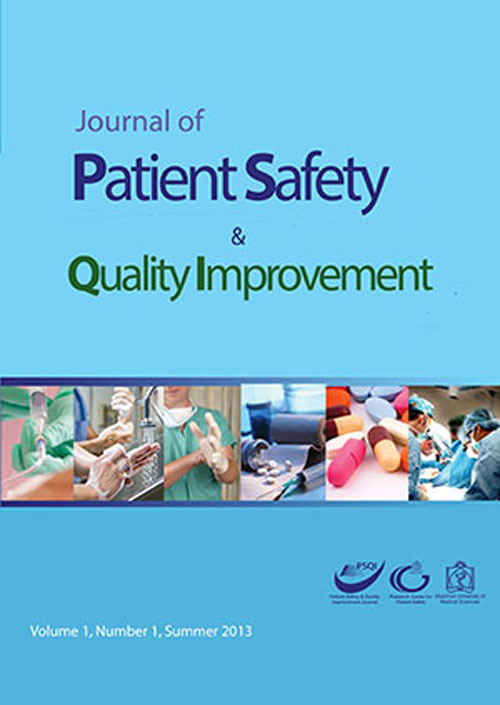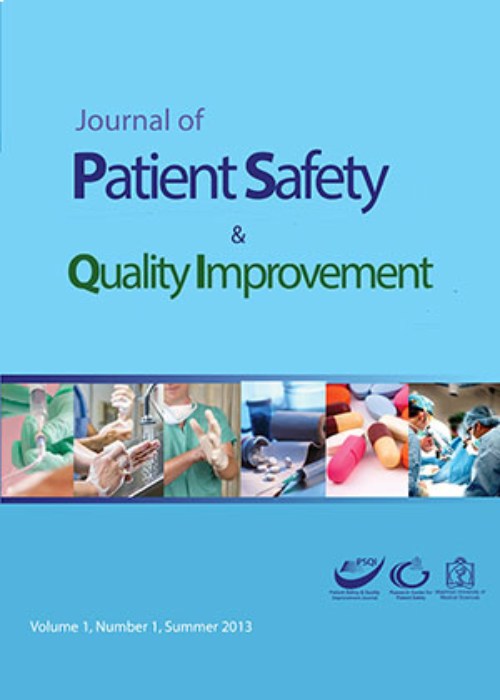فهرست مطالب

Journal Of Patient safety and quality improvement
Volume:4 Issue: 3, Summer 2016
- تاریخ انتشار: 1395/05/11
- تعداد عناوین: 8
-
Pages 388-393IntroductionPatient safety culture plays a pivotal role in the improvement of patient safety level in health centers. This study aimed to assess patient safety culture in the pharmacies affiliated to Mashhad University of Medical Sciences, Iran using a standard questionnaire developed by the American Agency for Healthcare Research and Quality (AHRQ).Materials And MethodsThis analytic, descriptive, cross-sectional study was conducted on 108 pharmacists and pharmacy technicians in Mashhad, Iran in 2015. Participants were selected via random cluster sampling. Data were collected using the Pharmacy Survey on Patient Safety Culture (SOPS). Data analysis was performed in SPSS Version 16 at the significance level of 0.05.ResultsAmong various dimensions of patient safety culture, communication openness had the highest mean score (0.63±4.27) as obtained by the pharmacists, while pharmacy technicians had the highest mean score in the dimension of teamwork (0.58±4.18). Moreover, the lowest mean score was observed in the dimension of overall perceptions of patient safety in both sample groups.ConclusionAccording to the results of this study, commitment of healthcare authorities to patient safety culture is the most important factor in the promotion of organizational patient safety. Considering that the lowest score of patient safety culture belonged to the dimension of overall perceptions of patient safety,it is recommended that related training interventions be implemented for healthcare staff in order to establish and promote the patient safety culture in pharmacies.Keywords: Culture, Patient Safety, Pharmacy
-
Pages 394-399IntroductionEstablishment of patient safety culture is the first step in the improvement of patient safety. As such, assessment of patient safety culture in hospitals is of paramount importance. Patient safety culture is an inherent component of organizational culture, so that the study of organizational culture is required in developing patient safety. This study aimed to evaluate patient safety culture among the clinical staff of a hospital in Jakarta, Indonesia and identify organizational culture profile.Materials And MethodsThis cross-sectional, descriptive, qualitative study was conducted in a hospital in Jakarta, Indonesia in 2014. Sample population consisted of nurses, midwives, physicians, pediatricians, obstetrics and gynecology specialists, laboratory personnel, and pharmacy staff (n=152). Data were collected using the Hospital Survey on Patient Safety Culture developed by the Agency for Healthcare Research and Quality (AHRQ) and Organizational Culture Assessment Instrument (OCAI).ResultsTeamwork within units was the strongest dimension of patient safety culture (91.7%), while staffing and non-punitive response to error were the weakest dimensions (22.7%). Moreover, clan culture was the most dominant type of organizational culture in the studied hospital. This culture serves as a guide for the changes in the healthcare organization, especially in the development of patient safety culture.ConclusionAccording to the results of this study, healthcare providers were positively inclined toward the patient safety culture within the organization. As such, the action plan was designed through consensus decision-making and deemed effective in articulating patient safety in the vision and mission of the organization.Keywords: Clan culture, Clinical staff, Hospital, Organizational culture, Patient safety culture
-
Pages 400-404IntroductionMedication error is one of the quality problems in hospitals harming millions of people around the world every year. This study aimed to investigate the occurrence and reporting of medication errors by nurses in hospitals affiliated with Mashhad University of Medical Sciences, Mashhad, Iran.Materials And MethodsThis descriptive cross-sectional study was conducted on 530 nurses selected by simple and stratified random sampling in 2014. Data were collected using a survey consisting of four sections and 66 questions, scored based on a Likert scale (87% return rate). Data analysis was performed in SPSS Version 18 using descriptive statistics, ANOVA test, and chi-square test. P-value of less than 0.05 was considered statistically significance.ResultsThe most prevalent medication errors by nurses was early or late administration of medication (43.7%), which was attributed to individual factors by the managers in the viewpoint of the nurses (mean: 3.66.3). In addition, the occurrence of medication error might be due to the hospital ward patient overcrowding (4.29.07). No significant relationship was observed between the variables of medication error, the causes, and lack of error report with gender and nursing experience (P=0.6 and P=0.8, respectively).ConclusionOne of the effective methods for prevention of medication error is providing teaching courses for nurses to raise their knowledge in this regard and aware them of the outcomes of wrong medication prescription.Keywords: Hospitals, Mashhad University of Medical Sciences, Medication errors, Nurses
-
Pages 405-409IntroductionThe study was examined effect of puberty education on knowledge, attitude and function in girl's student in Jiroft.Materials and Methodsthis was a quasi experimental study and the target population was girl's student at grade 1 high school in jiroft city and 40 girls were selected and were educated in a 12 sessions. The content of the educational course including physical signs of puberty, physiologic change in menstrual period, nutrition, sleep and psychological changes. The subjects completed in pretest and posttest a researcher made questionnaire that measure knowledge, attitude and function. The data was analyzed using descriptive indexes, t- and F-tests. The significant level was considered in less than 0.05.ResultsThe results showed that the average difference between pre-test and post-test knowledge, attitude and function in both experimental and control groups was significant (pConclusionResults maintained the importance of puberty education in improving knowledge, attitude and function of female students.Keywords: Attitude, Function, knowledge, Puberty
-
Pages 410-411IntroductionTo evaluate serum level of plasma soluble human leukocyte antigen-G (sHLA-G) in asthmatic children aged 2 to 14 years old.Materials And MethodsThis prospective, cross-sectional study was conducted on 83 patients aged 2-14 years in Ghaem Hospital, Mashhad, Iran, during 2013-2015. The participants were divided into two groups of asthmatic patients (n=29) and healthy children (n=54). Blood samples were drawn from the case (on admission) and control groups.ResultsIn the control group, 33 cases were male (61.1%) and 21 (38.9%) were female. In the case group, 18 patients (62.1%) were male and 11 (37.9%) were female (P=0.65). Mean ages of the control and case groups were 4.75±3.57 and 4.93±2.38 years, respectively (P=0.17). Mean serum levels of sHLA-G in the control and case groups were 396.51±279 U/ml and 184.58±302.08 U/ml, respectively (PConclusionSerum level of sHLA was significantly lower in the asthmatic children compared to healthy ones.Keywords: Asthma, Children, sHLA, G
-
Pages 412-415IntroductionSuggestion system is a cooperative management method, which has been applied in organizations during the recent years. Suggestion system provides an opportunity for the staff, customers, and contractors to submit their ideas and suggestions to the manager to be applied if befitting. In this study, we aimed to evaluate efficacy of the suggestion system in Hashemi Nezhad Hospital of Mashhad University of Medicine Sciences.Materials And MethodsThis descriptive survey was performed in all the staff (n=110) of Hashemi Nezhad Hospital of Mashhad, in 2012. The data collection instrument, which was a self-designed questionnaire including 22 items in three domains of hospital performance, efficiency, and personnel satisfaction, was distributed among the personnel. Validity of the questionnaire was determined by 10 Management experts, and its reliability was confirmed by a pilot study and Cronbach's alpha (α=0.9). The data were analyzed using SPSS Version 16.ResultsThe results indicated that suggestion system had a moderate effect on all the three domains (hospital performance [38.51%], efficiency of hospital [37.57%], and personnel satisfaction [32.88%]).ConclusionEfficacy of the suggestion system was in an average level. Conducting further studies on problems before the implementation of suggestion system can be effective in promoting efficacy of this system.Keywords: Efficacy, Hospital performance, Suggestion system
-
Pages 416-422IntroductionComplaint is the expression of dissatisfaction with an organization in relation to its products or services. The aim of this study was to investigate the complaint management process in hospitals affiliated to Kashan University of Medical Sciences and to propose solutions for the improvement of this process.Materials And MethodsThis cross-sectional, applied study was performed in 2013 at all hospitals affiliated to Kashan University of Medical Sciences, Kashan, Iran. The study was conducted in two major steps, i.e., evaluation of the process and solution delivery. The study population in the evaluation step comprised of 27 individuals who were involved in the complaint management process. On the other hand, 40 experts were recruited in the second stage. Sample selection was performed through targeted random sampling. Data were collected, using a checklist which was based on the national and international standards. The checklist, consisting of 101 yes/no questions was completed via interview and observation. Also, the expert comments were collected through Delphi technique. For statistical analysis, descriptive statistics were calculated, using SPSS Version 16.ResultsBased on the findings, 8 (29.6%) out of 27 participants stated that patients had access to information related to the process of complaint registration. All 27 (100%) participants claimed that no committees at hospitals were responsible for investigating patient complaints, although the patients could completely track their complaints.ConclusionBased on the findings, there was inadequate information regarding the process of patient complaint management in the evaluated hospitals.Keywords: Complaints, Complaint handling process, Complaint management, Improvement of performance
-
Lupoid Cutaneous Leishmaniasis: ReviewPages 423-425IntroductionLeishmaniasis is an infectious disease currently threatens 350 million people in 88 countries. Lupoid leishmaniasis occurs as a result of the host response, in which despite an intensified hypersensitivity the cell mediated immunity cannot sterilize lesions. A chronic granulomatous inflammation remains active for a long time. To summarize the articles published about Lupoid leishmaniasis.Materials And Methodsa systematic web base search was conducted in PubMed up to July 2015.
We included articles with available abstract in English language. Manual searching was done within the reference list of articles.ResultsTwo reviewers independently reviewed and assessed eligibility criteria, assessed quality, and extracted data.ConclusionSome patients have periods of relapse and remission at the site of inoculation of parasites and others suffer from chronic injury for years. In the case of effective disease treatment several studies have been conducted, so far, no satisfactory results have been achieved.Keywords: Chronic, Leishmaniasis, Lupoid leishmaniasis


